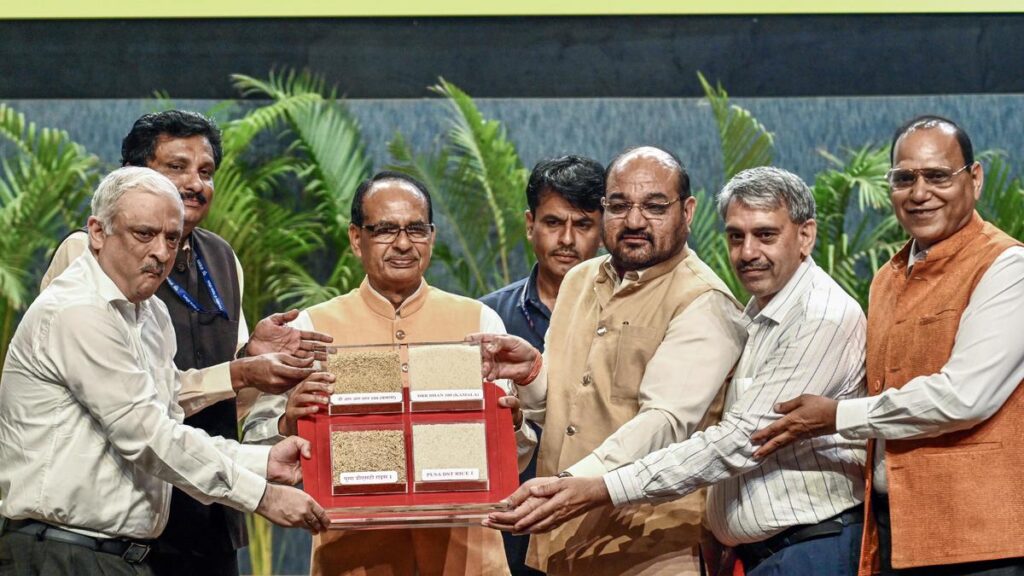
Union Minister of Agriculture Shivraj Singh Chouhan launches two genome-edited varieties of rice by ICAR, at the Bharat Ratna C. Subramaniam Auditorium, NASC Complex in New Delhi on MAY 4.
| Photo Credit: ANI
The story so far: Union Agriculture Minister Shivraj Singh Chouhan recently announced that India has become the first country in the world to develop rice varieties using genome editing technology. The new seeds will be available for farmers after the required clearances within six months and large-scale seed production will probably take place during the next three crop seasons.
What are the new varieties?
A team of researchers from various institutions, guided by the Indian Council of Agricultural Research (ICAR), were behind the development of the two varieties — the DRR Dhan 100, also known as Kamala, which was developed from a popular high yielding green rice Samba Mahsuri, and Pusa DST Rice 1, which was developed from the Maruteru 1010 (MTU1010) variety.
What are its peculiarities?
According to the ICAR, the increase in food demand, challenges posed by climate change and increasing biotic and abiotic stresses such as pest attacks and scarcity of water, led to the development of high yielding, climate resilient and nutritionally rich crop varieties. Kamala has shown superior yield, drought tolerance, high nitrogen use efficiency and 20 days earliness over its parent variety. It has an average yield of 5.37 tonnes per hectare against the 4.5 tonnes per hectare of Samba Mahsuri across two years and 25 locations of testing in the country. “The earliness trait will help in saving water, fertilizers, and reduced emission of methane,” the ICAR said. The second variety, Pusa DST Rice 1, has a yield of 3,508 kilograms per hectare (a capacity of 9.66% more) over the parent rice variety, MTU 1010, which has an average yield of 3,199 kg per hectare under ‘inland salinity stress’. It also showed a superiority of 14.66% over the MTU 1010 under alkalinity conditions, and a 30.4% yield advantage under coastal salinity stress.
What was the technology used?
According to Joint Director (Research), Indian Agricultural Research Institute, Viswanathan. C, scientists have used Site-Directed Nuclease 1 and Site-Directed Nuclease 2 (SDN-1 and SDN-2) genome editing techniques to develop the seeds. Though this technique was used to develop different crops since 2001, such as tomatoes, a fish variety in Japan and a soybean variety in the U.S., making a rice variety has been done for the first time. In 2020, the first peer-reviewed research paper on Pusa DST Rice 1 was published, which got cited in more than 300 papers since then. The paper on Kamala is in the stage of publication. “The international research community has approved both the varieties,” Dr. Viswanathan said.
Are they GM crops?
Dr. Viswanathan says that since the genome editing technology SDN-3 is not involved in this process, they are not genetically modified (GM) crops. In the SDN-1 approach, scientists make a cut and the repair is done automatically while in SDN-2, scientists give guidance to the cell to do the repair and the cell copies it. In SDN-3, however, scientists introduce a foreign gene from other varieties and integrate it into the improved varieties. This process is considered as genetic modification. In this case, the mutant was developed without any foreign gene and mutation occurred through natural process. This is a precision mutation technique and several countries have exempted this process from the regulations required for developing GM crops. “No foreign gene is there in these crops, only the native gene is there in the final product,” Dr. Viswanathan said. A team of scientists from various governmental institutions were part of this research. It was tested in the fields under the All India Coordinated Research Project on Rice during 2023 and 2024.
What are the objections?
Venugopal Badaravada, who was a farmers’ representative in the ICAR governing body said that the ICAR’s genome-edited rice claims are premature and misleading. A day after the announcement he said in a statement that farmers demand accountability, transparent data, and technologies that are tested in our fields — not just polished press releases. He was expelled from the governing body soon after this and the ICAR accused Mr. Badaravada of spreading falsehoods about the institution.
The Coalition for a Genetically Modified-Free India, a group of activists who are fighting a case against GM crops in the Supreme Court, said the biotech industry and lobbies have resorted to falsely portraying gene editing as a precise and safe technology, whereas published scientific papers show that this is untrue. “India’s de-regulation of two kinds of gene editing is outright illegal,” the organisation said. They claimed that gene editing tools are proprietary technologies under Intellectual Property Rights (IPR) ownership and have a direct bearing on the seed sovereignty of the country’s farming community. “The Government of India has to reveal the situation with regard to IPRs on the released varieties transparently, immediately. The Government of India is compromising on farmers’ seed sovereignty and our food sovereignty by bringing in technologies entangled in IPR issues,” they said.
Published – May 15, 2025 08:30 am IST

